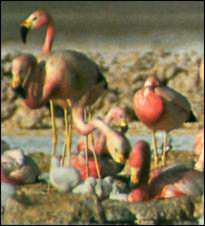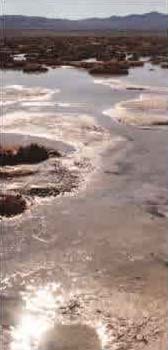 In Northern Chile, the Andean Flamingo is dying. Every year fewer are born, and the cause is apparently related to drought conditions that have been plaguing the region since 1987. Fortunately for the flamingo, a sizable copper deposit was discovered near their natural habitat, and the environmental baseline studies identified the plight of this large bird.
In Northern Chile, the Andean Flamingo is dying. Every year fewer are born, and the cause is apparently related to drought conditions that have been plaguing the region since 1987. Fortunately for the flamingo, a sizable copper deposit was discovered near their natural habitat, and the environmental baseline studies identified the plight of this large bird.
The flamingos unlikely savior, the Escondida copper mine, has voluntarily undertaken scientific studies to help save the Andean Flamingo population.
In 1988, before starting mining operations in Chiles Atacama Desert, studies were carried out in the mining area and in the Punta Negra Salt Pan Basin. They found the only water source in the area to be underground water close to the flamingos habitat during summer months where they come to feed and breed.
According to Rene Kurte, subdirector of the Agriculture Department in Antofagasta, Chile, the flamingos breeding colonies have been gradually decreasing in size since 1988. And since 1992, the breeding success of the Andean Flamingos colonies in Northern Chile has been practically zero.
 "The abundance of the Andean Flamingo in Chile during the summer months greatly depends on the success of the breeding colonies," said Mario Parada, Escondidas biologist who has developed innovative projects to preserve the species. "Their reproductive success varies from year to year and depends on prevailing weather conditions in the breeding areas. The lack of rainfall and excessive evaporation may cause the breeding lagoon areas to dry up, thus preventing the female birds from building nests or making them prey to predators such as foxes," he said.
"The abundance of the Andean Flamingo in Chile during the summer months greatly depends on the success of the breeding colonies," said Mario Parada, Escondidas biologist who has developed innovative projects to preserve the species. "Their reproductive success varies from year to year and depends on prevailing weather conditions in the breeding areas. The lack of rainfall and excessive evaporation may cause the breeding lagoon areas to dry up, thus preventing the female birds from building nests or making them prey to predators such as foxes," he said.
The Culpeo Fox is the Andean Flamingos primary predator. In mid-1996, Parada initiated a radio-tracking project to discover the foxes domain and evaluate its impact on the flamingos nesting colonies. "This project will allow for potential seasonal technical controls of the impact of the Culpeo Fox, and provide a monitoring tool for the conservation of the Andean Flamingo by increasing the odds of success of its reproductive process," said Parada.
Another negative factor influencing the flamingos reproductive process is the harmful effect of waves on the mud nests. In fact, its the leading cause of destroyed eggs in the flamingos breeding colonies in the Punta Negra salt pan. During the 1991-92 breeding season, Parada conducted an experiment using artificial nests as "wave breakers" to protect the natural nests. The flamingos accepted the artificial nests; 94 percent of the nests had eggs, and a 65 percent survival rate of chicks born in the artificial nests was achieved.
The flamingos also contributed to their own decline by abandoning their egg-filled nests. Abandoning nests is common among reproducing flamingo colonies and results from changes in water levels or the presence of predators. Paradas newest experiment involves rescuing abandoned eggs, artificially assisting in the post-egg laying reproductive process, and then artificially feeding the abandoned chicks.
Escondida has gathered information of significant scientific value regarding Andean natural habitats. "The tools we have developed are not limited to flamingos and Chile. This knowledge is valuable to the worldwide scientific community," said Marius Smit, manager of environment at Escondida.
How does Escondida benefit from preserving the Andean Flamingo? "These programs strengthen our relationship with the regulatory authorities with whom we work very closely. They provide us with technical assistance and with advice in our programs. The governmental agencies now look on Escondida favorably, and that obviously spills over into the community," said Smit.
Of course, theres still the question of whether human beings should intervene in natural processes. According to Smit, the Chilean government will ultimately make the decision about allowing human intervention to correct a dangerously low flamingo population. Rene Kurte voiced his opinion eloquently, "Personally, I believe in life and in a superior being that placed those birds in our midst to share this planet with us. They are part of our culture and a symbol of wildlife and beauty in desolate areas."
Attribution
"I believe in life and in a superior being that placed those birds in our midst to share this planet with us. They are part of our culture and a symbol of wildlife and beauty in desolate areas," said Rene Kurte, subdirector of the Chilean Agriculture Department.
The flamingoes accepted the artificial nests; 94 percent of the nests had eggs.
This article is reprinted with permission from the publication, On CU, January - March, 1997 Vol. 1, No. 2.
On CU
is the quarterly publication of BHP Copper, a business group of The Broken Hill Proprietary Corp., Ltd.
© 1997 BHP Copper
![]()
BHP Copper
550 California Street
San Francisco,
California 94104
